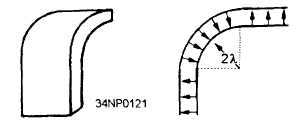Figure 3-47.—Terminating waveguides.
of force. When the H lines cut through the wedge,
current flows in the wedge and causes a power loss.
As with the other methods, this loss is in the form
of heat. Since very little energy reaches the end of
the waveguide, reflections are minimum.
All of the terminations discussed so far are
designed to radiate or absorb the energy without
reflections. In many instances, however, all of the
energy must be reflected from the end of the
waveguide. The best way to accomplish this is to
permanently weld a metal plate at the end of the
waveguide, as shown in view D of figure 3-47.
WAVEGUIDE PLUMBING
Since waveguides are really only hollow metal
pipes, the installation and the physical handling of
waveguides have many similarities to ordinary
plumbing. In light of this fact, the bending, twisting,
joining, and installation of waveguides is commonly
called waveguide plumbing. Naturally, waveguides
are different in design from pipes that are designed
to carry liquids or other substances. The design of
a waveguide is determined by the frequency and power
level of the electromagnetic energy it will carry. The
following paragraphs explain the physical factors
involved in the design of waveguides.
Waveguide Bends
The size, shape, and dielectric material of a
waveguide must be constant throughout its length for
energy to move from one end to the other without
reflections. Any abrupt change in its size or shape
can cause reflections and a loss in overall efficiency.
When such a change is necessary, the bends, twists,
and joints of the waveguides must meet certain
conditions to prevent reflections.
Waveguides maybe bent in several ways that do
not cause reflections. One way is the gradual bend
shown in figure 3-48. This gradual bend is known
as an E bend because it distorts the E fields. The E
bend must have a radius greater than two wavelengths
to prevent reflections.
Figure 3-48.—Gradual E bend.
Another common bend is the gradual H bend (fig.
3-49). It is called an H bend because the H fields
are distorted when a waveguide is bent in this manner.
Again, the radius of the bend must be greater than
two wavelengths to prevent reflections. Neither the
E bend in the “a” dimension nor the H bend in the
“b” dimension changes the normal mode of operation.
Figure 3-49.—Gradual H bend.
3-22






